I slept horribly. I think I was up at 2 or 3 but I didn’t check. My cold was in full force by this point and I think I even worried I had a fever at some point. I didn’t manage to get back to sleep and I felt better once Jenn woke up, but I still felt awful. Fortunately the hotel had congee. And it was pretty damn good. Restorative, for sure.
There was a miscommunication with our hotel and they had only booked a driver. To their credit, they had a guide for us in about 20 or 30 minutes.
I’m not sure I believe in a “bucket list” exactly. And I feel weird using the term ever since that stupid movie came out. But if I had a bucket list of places I want to see before I die, Angkor Wat was on it. The largest religious complex in the world, so I’m told, Angkor Wat is hundreds if not thousands of temples in 163 hectares. It is so big there is no way I can possibly convey its size to you. This video only shows you some highlights:
It’s much bigger than that. But the thing is, you can’t see it all in a day. In fact, they sell 7-day tickets for those who want to attempt to explore the entire thing. We budgeted a day, so we had to do the “Petite Circuit” only and were limited to three temples.
Angkor Wat
The complex is named after its largest temple. This temple is certainly the largest I’ve ever seen. It and many if not most of the other temples are about the age of a medieval castle, so they’re not as old as Roman ruins but I’m not sure it’s any less impressive, given both its size and the complexity of the stonework, something which must be seen to be believed.
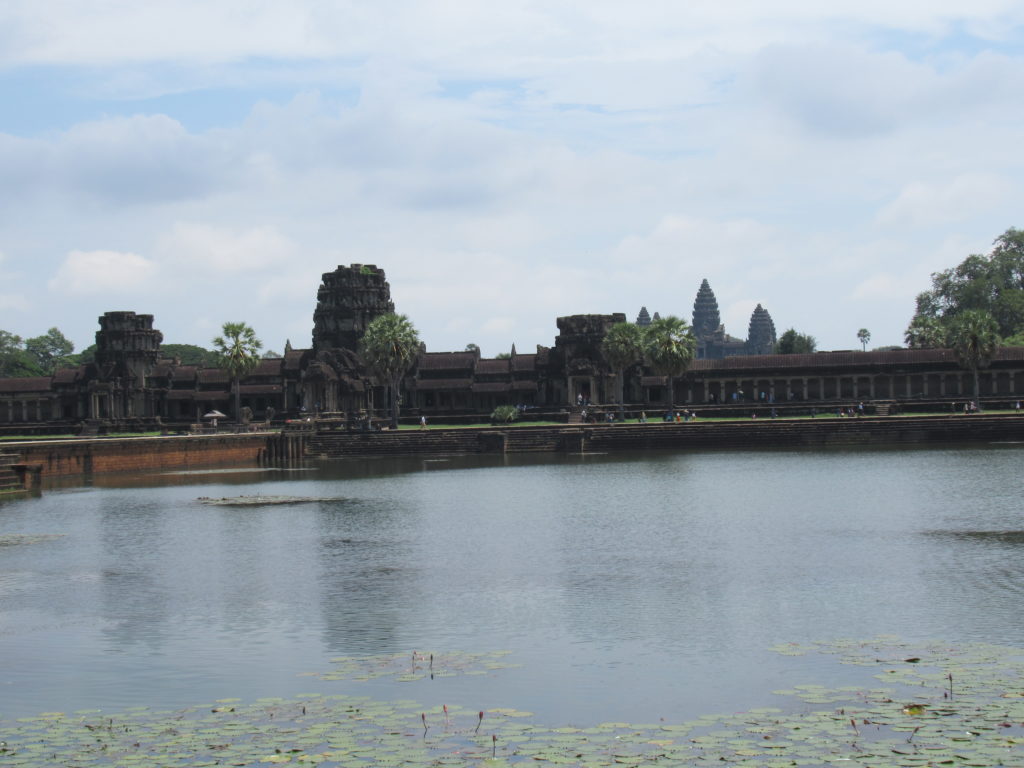
I took way too many pictures, most of which I am not super happy about. I’ll spare you them here but just say that the main temple is three levels and is post extremely high and extremely large. It is in the middle of a complex surrounded by the massive wall you see in the above picture. (The building in the distance is the main temple.)
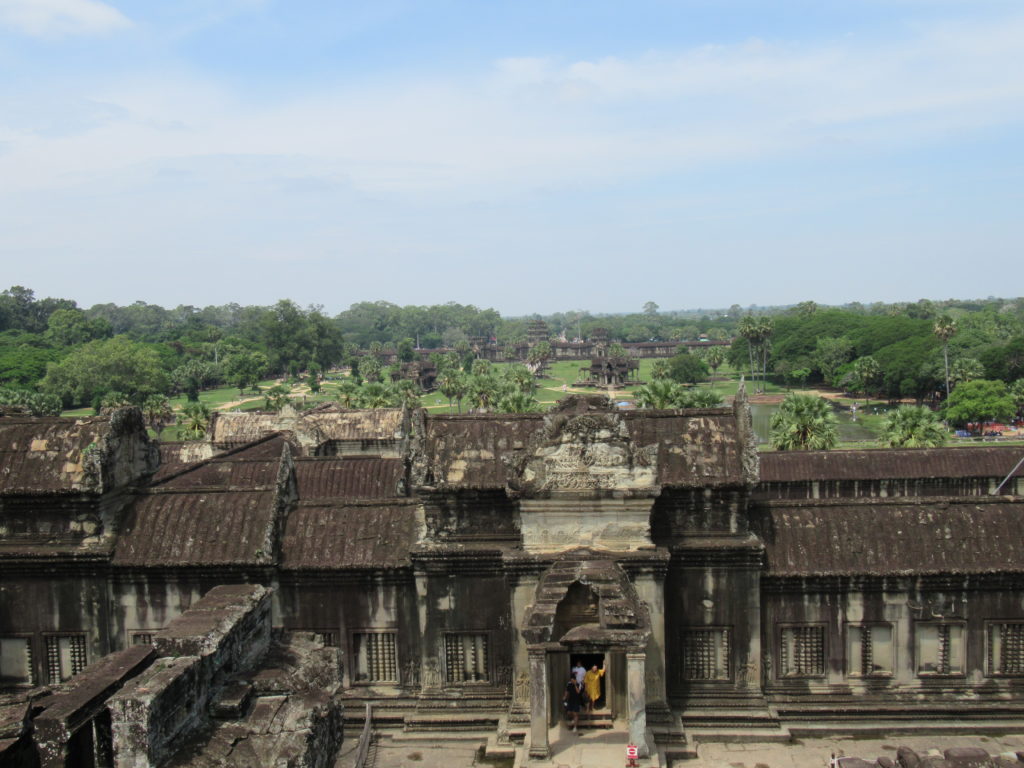
It was super busy, because it was a festival day and the temple was overrun with locals in addition to the tour groups. (Yes, this site is over touristed, but there’s a reason.)
It was also unbelievably hot. There was one point on our way out that I experienced what was possibly the hottest temperature I think I can remember experiencing in my life. It was less humid than Vietnam, though. So that’s something.
Because we were clearly so hot, our guide convinced us to stop for lunch. We had some Cambodian soup – mine was sour – which was somewhere on the spectrum between Thai and Vietnamese or Chinese and it was quite good. I also managed to have a milkshake.
Ta Prohm (“Jungle Temple”)
Our next stop on the “greatest hits” of this complex was the “jungle temple”, the one major temple that has been left to the elements. Because of this it has become a favourite of Hollywood and, as a result, has become required visiting for tours coming to the complex.
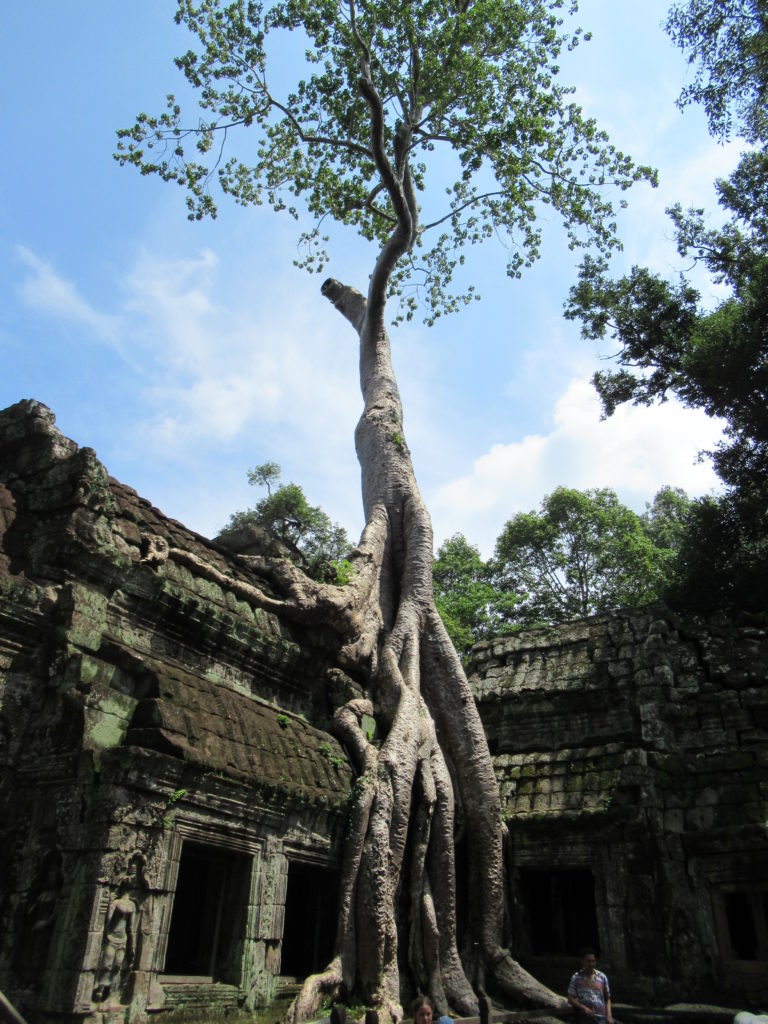
Though Ta Prohm is a lot smaller than Angkor Wat, it is still quite large and has considerably more atmosphere as a kind of “lost city” because of the sheer number of gigantic trees which have climbed onto it. I have never seen anything like it.
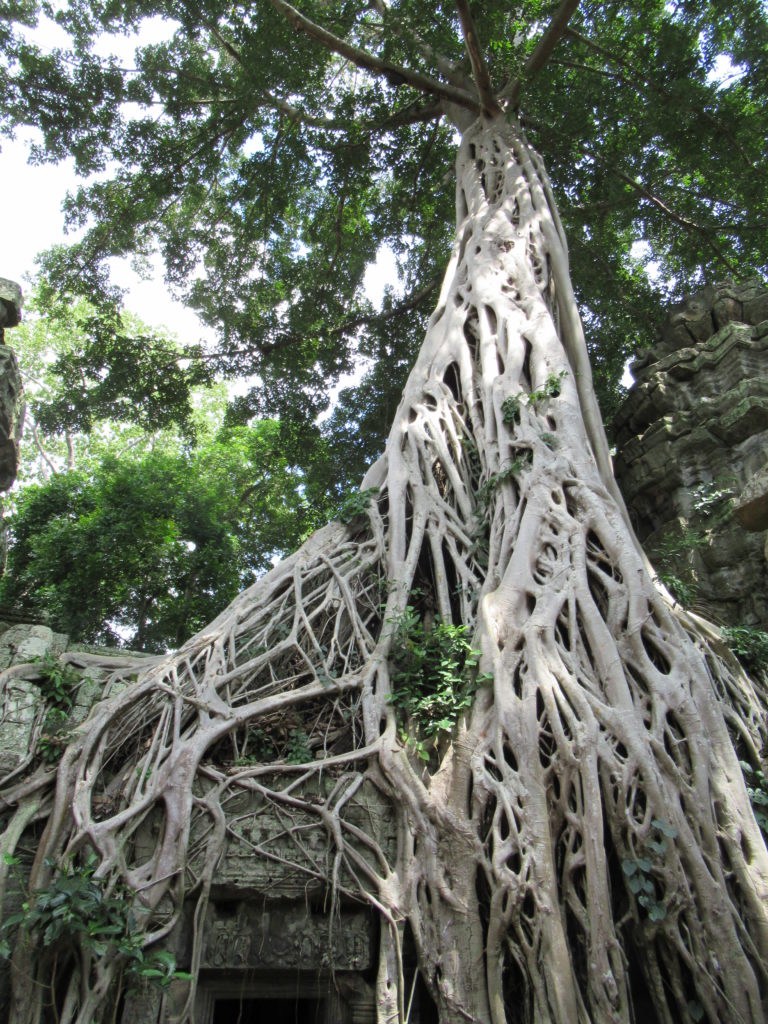
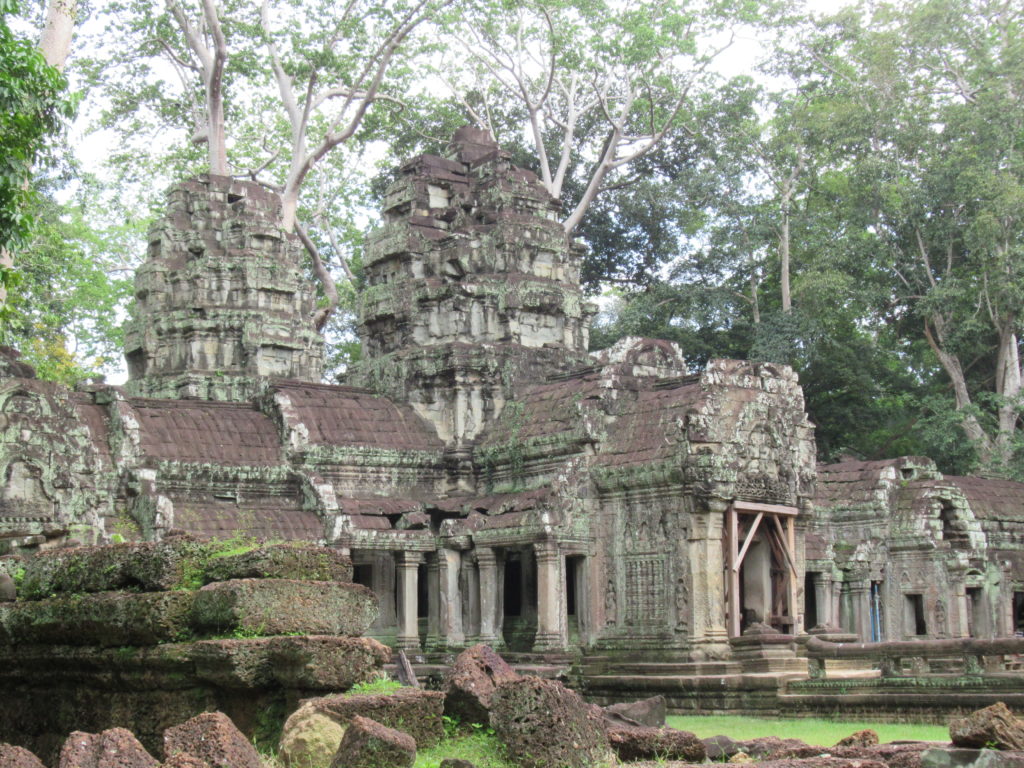
Ta Prohm is also the site of a fascinating shrine which you can enter and have a truly unique experience. In this shrine you stand near one of the four walls and beat your chest with your fist, the shrine then echoes the sound of you thumping your chest. The Khmer apparently considered this talking to god. It’s pretty neat.
Angkor Thom
Lastly, there’s Angkor Thom, a much larger complex than Angkor Wat with relatively smaller temples (which are still huge). Angkor Thom is 9 square kilometres, so you will not be surprised to learn we only went to one temple within the complex, Bayon.
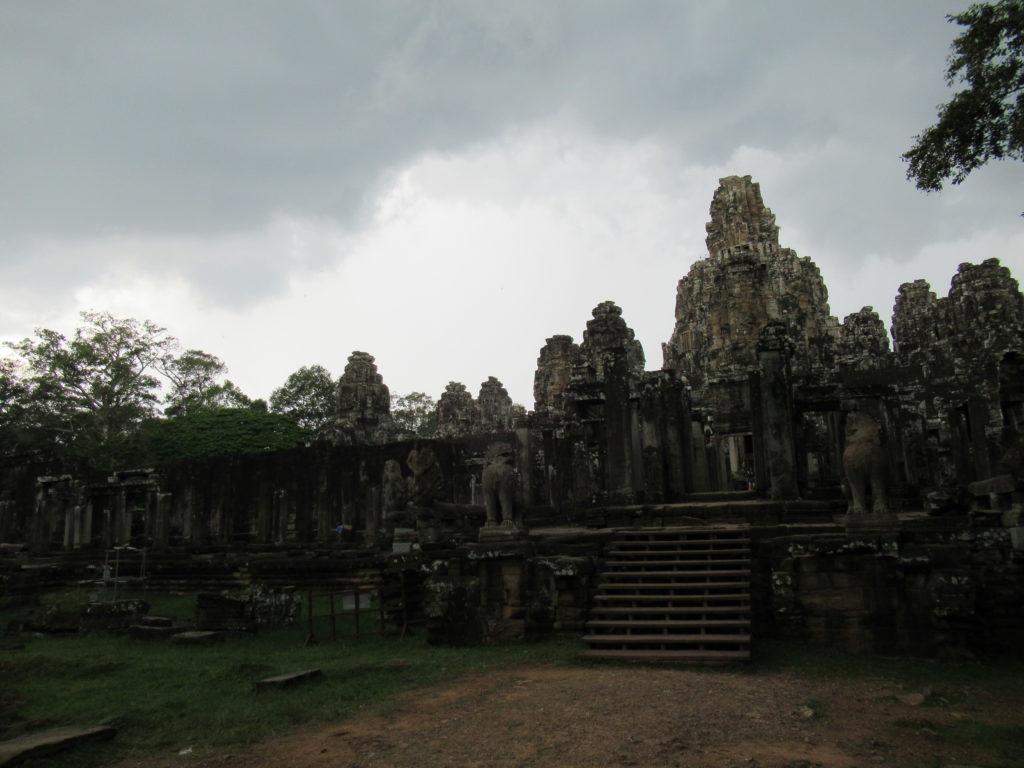
Bayon is in rougher shape than Angkor Wat, though I believe it is slightly more recent. But it’s considerably more elaborate in terms of the decoration, which gives it a kind of mysterious air lacking at the big temple. Unfortunately, on our way up, the skies opened up and it just poured. (It was the rainy season, after all.) And so our exploration of this temple was cut a little short (though we had made it about half way up). However at this point we had been at the complex for 5 or 6 hours, so we were a little templed out and were quite ready to call it a day.
I’m not sure I have done enough to explain to you the sheer awe in me caused by this place. I don’t think I can put it into words. But it’s on my short list of the most incredible human-made places I have ever been to, along with the Hagia Sophia in Istanbul and Ephesus in southwestern Turkey. Though it is roughly the age of the castles of Europe, it is so much more impressive than any castle I’ve been to.
At this point I want to take a minute to acknowledge something our tour guides spoke to us about. Our (very young) tour guide in Saigon had mentioned that English-language tourism in Vietnam is declining as Chinese tourism increases. He bemoaned this because he doesn’t want to learn Chinese as he finds it hard to learn. Our Cambodian guide was far more open and direct about his feelings about Chinese tourists: he said he didn’t want to learn Chinese but also he felt like Chinese tourists are significantly harder to deal with than English and French tourists, as they are loud and demanding in ways that others are not. It seems the Chinese have replaced the Americans and the Brits as the obnoxious foreigners of the world, at least in Southeast Asia.
Moreover, according to our Cambodian guide, the Chinese are buying up land and services in order to serve the Chinese tourists. So oftentimes the Chinese will come to Cambodia, stay at a Chinese-owned-and-operated hotel, have a Chinese driver for their Chinese-owned bus, they will eat at Chinese restaurants and sometimes even have a Chinese tour guide.
He even claimed that Chinese are buying up land all over Siem Reap and then selling it to other Chinese at a massive markup. They will not sell it back to Cambodians and when the Chinese suckers who buy the land the second time (at a massive markup) they open businesses to serve Chinese tourists, rather than Cambodians.
I have heard a lot about how China is slowly replacing the United States as the investor in the less developed world, but rarely in those stories do you hear the other side of it, the local population’s perspective of how foreign investment and influence affects them. Yes, the Chinese are bringing lots of money to Siem Reap. Maybe they are even keeping the town afloat as western tourism declines, but foreign money is never just a positive.
Part way through the drive back to the hotel the sun came back out. So we decided to go for a swim in the small pool. Despite the rain we still felt pretty damn sticky, though far less hot.
After the swim we tried to find another of the high end Cambodian restaurants we had heard about but this one was inexplicably closed. Initially we thought it was opening later but we tried it again later only to find it was still closed.
In the meantime we walked across our side of town to go to a brewery. They only had a few beers of their own but the one I had was alright.
When we tried the restaurant again, only to find it inexplicably shut on a Friday night, we saw another one across the street which was packed. It seemed to be one of the few places open. I guess because of rainy season many restaurants just don’t bother opening.
Unfortunately the staff at the restaurant forgot about us so it took a very long time to get our food. When we did get it, the food was vaguely Japanese, for the most part, which was odd. However, we did try one Cambodian dish with ants! The ants didn’t taste like much of anything, but were crunchy, basically like diced nuts in terms of texture if not appearance.